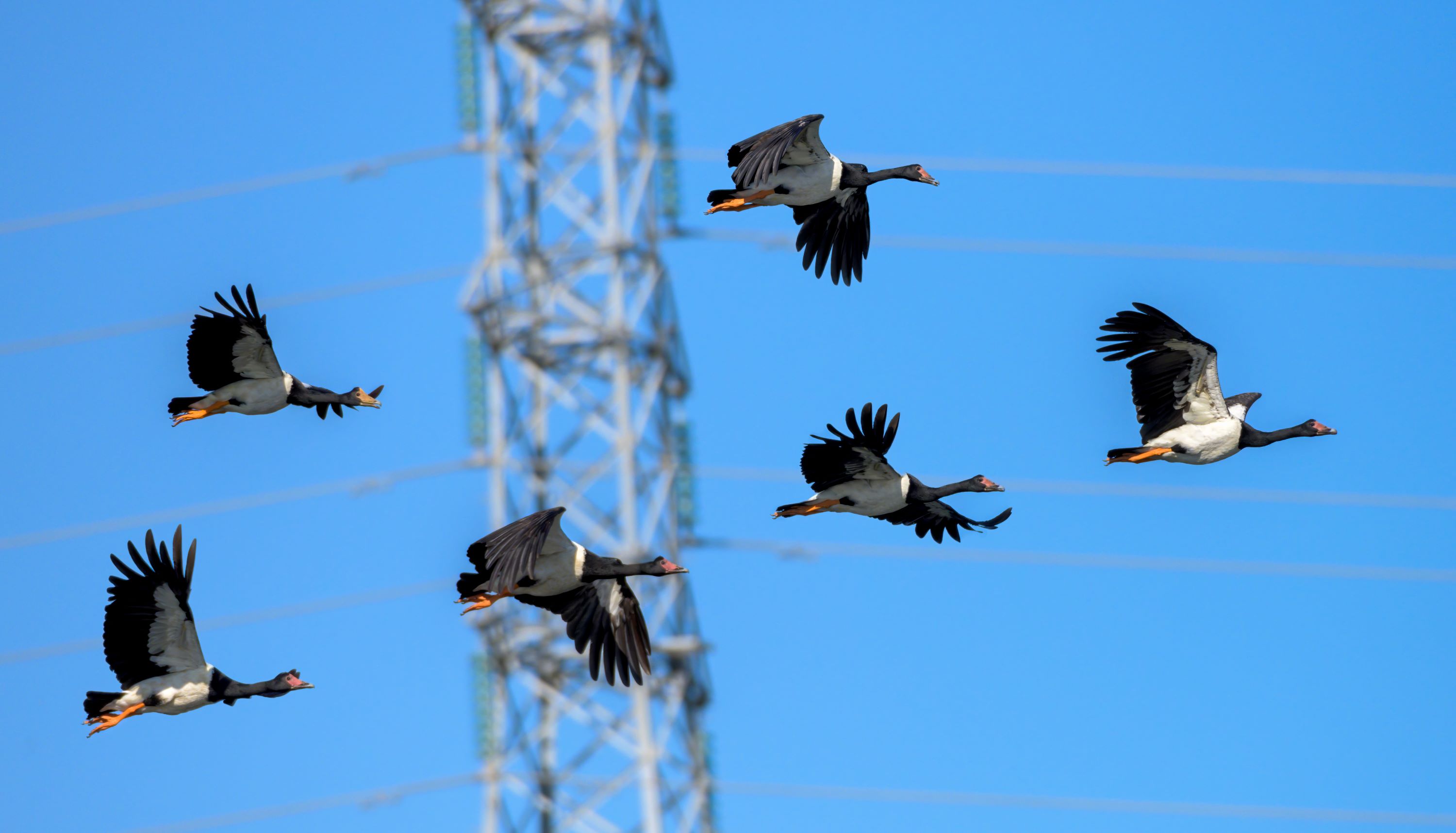
The Magpie Goose: An Avian Wonder from Australasia
Introduction
The Magpie Goose (Anseranas semipalmata) stands as an exceptional and captivating bird species, native to the vibrant and biodiverse landscapes of northern Australia and southern New Guinea. This bird, absent from the terrains of Utah and the wider North American continent, captivates ornithologists and bird enthusiasts globally with its distinctive characteristics and intriguing evolutionary history. The Magpie Goose is not just another member of the avian world; it is a species that commands attention due to its unusual physical attributes and behaviors.
Aesthetically, the Magpie Goose presents a striking figure, distinguished by a contrasting palette of black and white plumage. The bird's body is predominantly cloaked in a sleek, iridescent black, while its underbelly and wingtips boast a crisp, clean white. This dramatic coloration is complemented by its long, bare, orange-red face and legs, which inject a burst of vibrant color, making it a visually arresting sight in its natural habitat. The Magpie Goose's size is noteworthy as well, being larger and more robust than many typical waterfowl species, adding to its imposing presence.
From an evolutionary standpoint, the Magpie Goose holds a unique position, representing one of the more ancient lineages within the waterfowl family. It is a species that provides valuable insights into the early diversification of waterfowl, shedding light on the evolutionary pathways that have led to the rich variety of bird life we see today. Its partially webbed feet, an adaptation suited to its specific lifestyle, distinguish it from most other waterfowl and underscore its unique evolutionary journey.
In its native regions of northern Australia and southern New Guinea, the Magpie Goose is an integral part of the local avifauna. It thrives in the lush, wetland ecosystems of these areas, contributing to the ecological balance and showcasing the interdependence between species and their environments. The Magpie Goose's role in these ecosystems, combined with its distinctive characteristics, makes it a species of significant interest and importance, highlighting the diversity and complexity of waterfowl across the globe.
For birdwatchers and nature enthusiasts, the Magpie Goose is more than just an exotic bird from afar; it is a symbol of the incredible diversity that exists within the avian world. Its presence in the wetlands of Australasia is a reminder of the need to appreciate and understand the vast array of bird life that inhabits our planet and the critical importance of conserving their natural habitats for future generations.
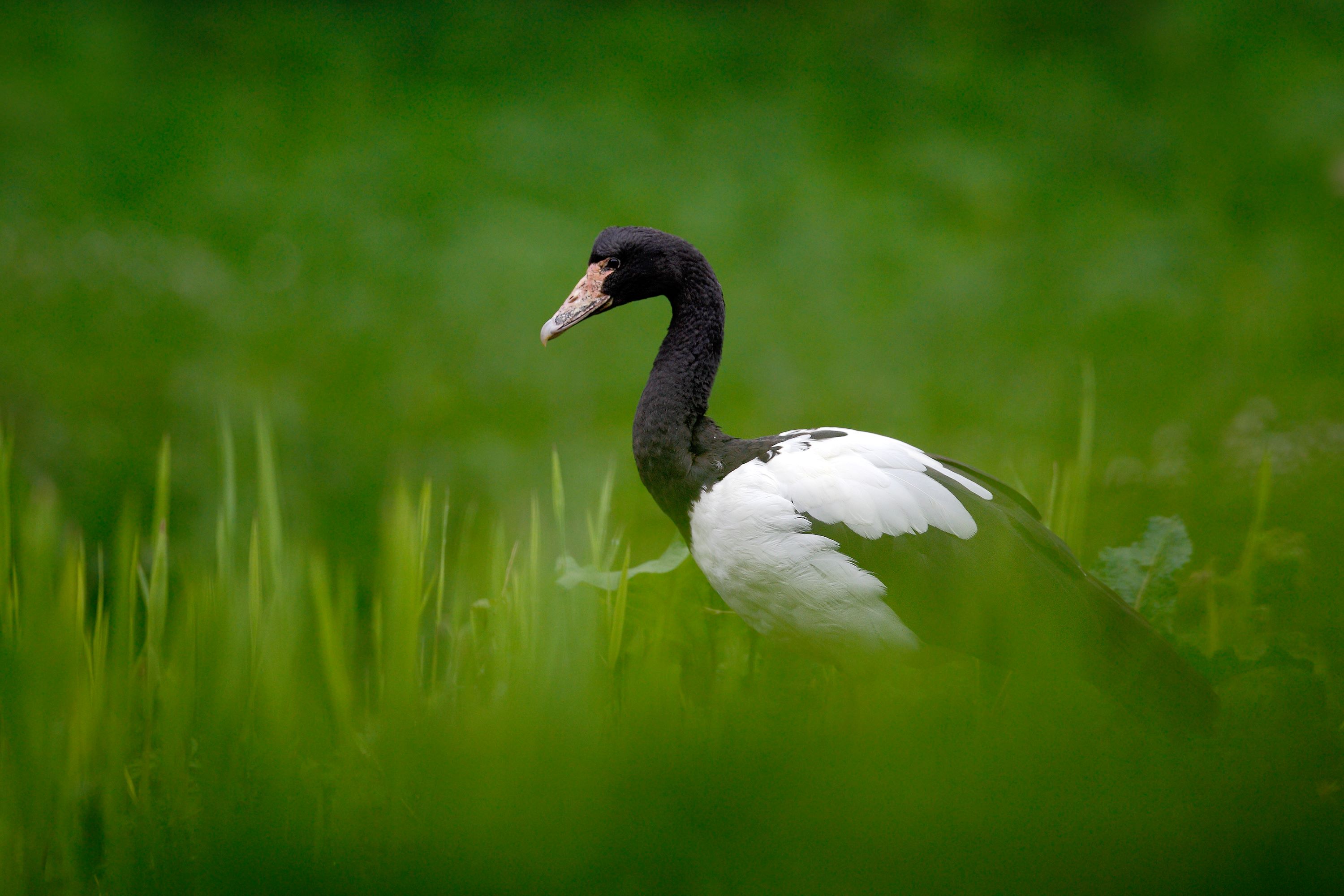
Description and Identification of the Magpie Goose
The Magpie Goose (Anseranas semipalmata) presents a captivating visual spectacle, distinguished by its bold and contrasting coloration and unique physical features. As a large bird, it commands attention with a body length typically ranging from 70 to 90 centimeters, making it one of the more sizable members of the waterfowl community. Its plumage is a study in contrasts: the predominant deep, iridescent black of its upper body and wings sharply juxtaposes with the striking white of its underbelly and the tips of its wings. In flight, this contrast is particularly dramatic, as the white wingtips become more pronounced against the bird’s dark body, creating a distinctive and memorable visual display.
One of the most striking features of the Magpie Goose is its long, bare face, which exhibits a vibrant orange-red hue, providing a stark contrast against its darker feathers. This bright facial coloring extends to its long, sturdy legs, enhancing the bird's overall striking appearance. The head is relatively small and compact in comparison to the body, with keen, alert eyes that add to its watchful demeanor.
A unique anatomical characteristic of the Magpie Goose is its partially webbed feet. Unlike the fully webbed feet typical of most waterfowl, which are adapted primarily for swimming, the Magpie Goose's feet are uniquely evolved to suit its lifestyle. The partial webbing is an adaptation that allows for efficient movement in its preferred habitat of wet, marshy environments. These feet enable the Magpie Goose to walk with ease on soggy, unstable ground, and also provide sufficient support for swimming in shallow waters. This adaptation is a key indicator of the species' evolutionary path and ecological niche, reflecting its semi-aquatic lifestyle in the tropical wetlands of Australia and New Guinea.
Overall, the Magpie Goose's distinctive appearance, from its contrasting plumage to its specialized feet, not only makes it easily identifiable but also highlights its unique place in the waterfowl family. These features are a testament to the bird's adaptation to its specific environmental conditions and offer an insight into the diverse morphologies that birds can evolve in response to their habitats.
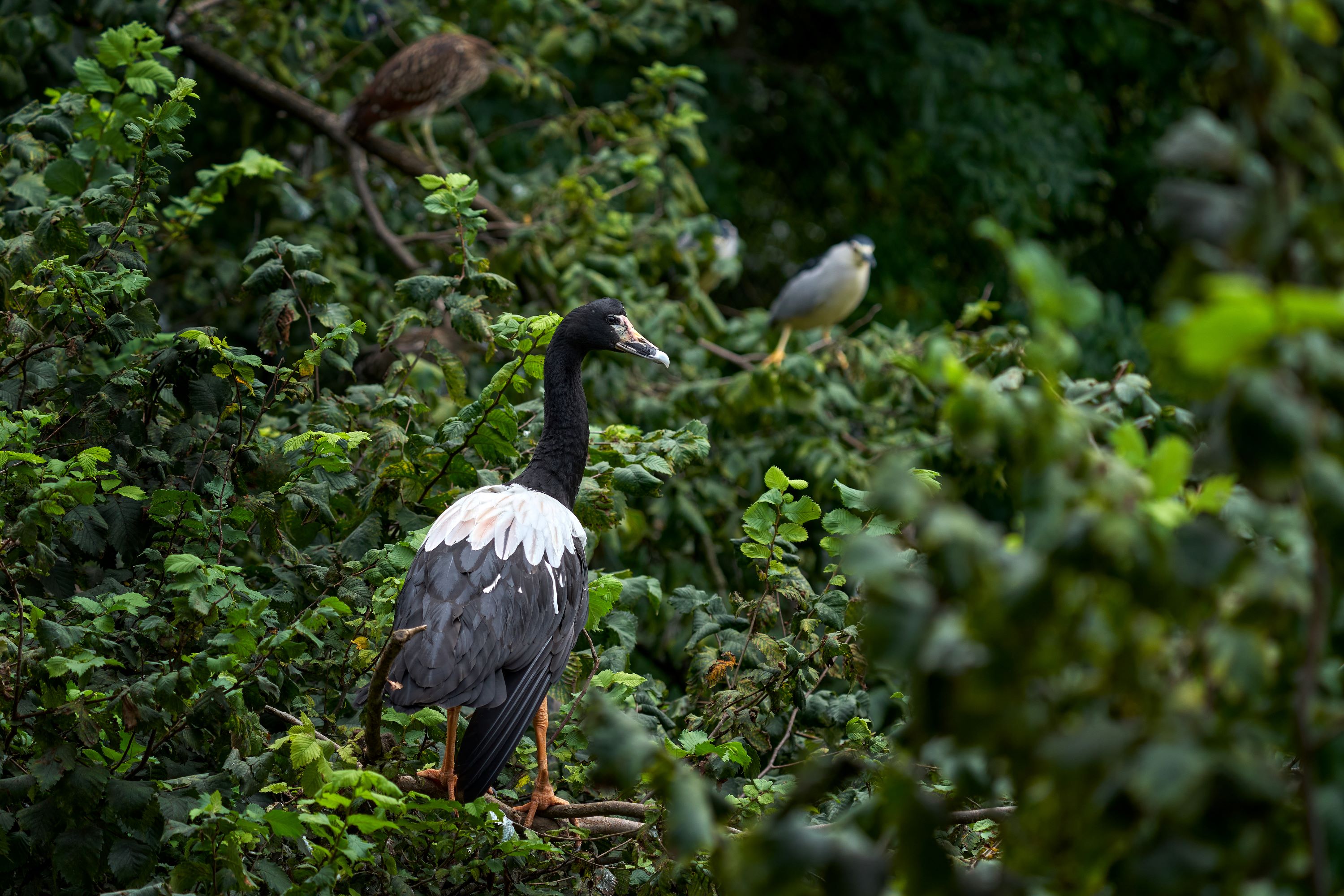
Habitat and Range of the Magpie Goose
The Magpie Goose (Anseranas semipalmata) is primarily found in the lush and dynamic ecosystems of northern Australia, with its range extending into the southern regions of New Guinea. This bird's habitat preference is deeply rooted in the tropical and subtropical climates of these areas, where it thrives in the richly biodiverse wetlands. The species has a particular affinity for expansive floodplains, which offer a mosaic of aquatic and semi-aquatic environments crucial for their survival. These floodplains undergo seasonal variations in water levels, creating a variety of habitats that support a wide range of plant and animal life.
In addition to floodplains, Magpie Geese are commonly found in wet grasslands. These areas, often adjacent to water bodies, provide an ideal foraging ground for the species, where they feed on a diverse diet of grasses and seeds. The wet grasslands also play a significant role during the breeding season, offering safe nesting sites that are proximate to feeding areas.
Another favored habitat of the Magpie Goose is shallow freshwater swamps. These swamps, with their standing water and dense vegetation, are not only crucial feeding sites but also serve as protective havens for the geese, especially during the breeding season. The swamps’ dense reed beds and tall grasses offer concealment from predators, while the water provides a barrier against terrestrial threats.
The selection of these habitats is closely linked to the Magpie Goose's life cycle, particularly its feeding and breeding behaviors. The abundance of food in these wetlands is a key factor in their habitat choice, ensuring that the birds have access to a steady food supply throughout the year. Similarly, the availability of safe and suitable nesting sites is essential for the successful rearing of their young.
The Magpie Goose’s habitat range highlights its dependence on wetland ecosystems, underscoring the importance of these environments for the survival of numerous species. The conservation of these habitats is crucial, not only for the Magpie Goose but also for the myriad of other species that rely on wetlands for their survival. The preservation and sustainable management of these habitats are vital in maintaining the biodiversity and ecological health of the regions where these unique birds reside.
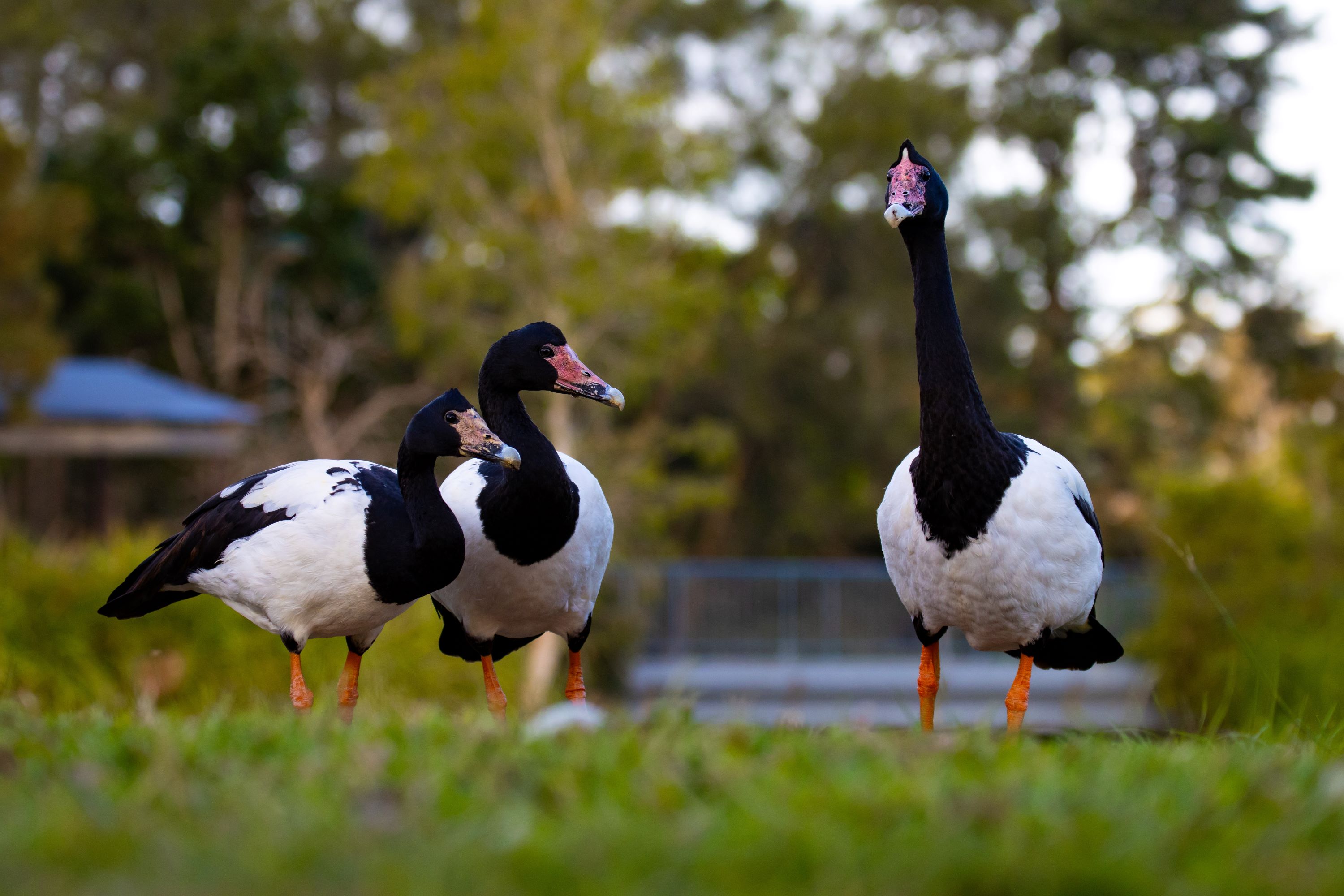
Behavior and Social Structure of the Magpie Goose
The Magpie Goose (Anseranas semipalmata) is renowned for its highly social nature, which is a defining aspect of its behavior and ecology. These birds are commonly observed congregating in large flocks, often comprising hundreds or even thousands of individuals, especially in favored feeding areas or during roosting at dusk. The spectacle of such large gatherings is not only a visual treat but also a testament to their complex social dynamics. Within these flocks, Magpie Geese engage in a range of social interactions, from cooperative feeding to collective alertness to potential threats, demonstrating a well-structured social organization.
One of the most striking behavioral traits of the Magpie Goose is its vocal communication. The species is known for its loud, resonant honking calls, which are a hallmark of their presence in their natural habitats. These calls serve multiple purposes, including maintaining flock cohesion, signaling alarm, and facilitating communication between individuals, particularly in dense vegetation where visibility is limited. The calls of the Magpie Goose can be heard over long distances, echoing across their wetland habitats, and play a crucial role in the birds' social interactions and group dynamics.
Despite their propensity for forming large flocks, Magpie Geese exhibit mostly sedentary behavior, with a strong fidelity to their chosen habitats. However, they are not entirely bound to one place throughout their lives. The species shows some degree of mobility, particularly in response to environmental changes. In regions where water levels fluctuate seasonally, Magpie Geese may undertake short migratory movements, traveling to areas where water and food resources are more readily available. These movements are typically localized and influenced by the availability of suitable wetlands and feeding grounds. The capacity for such mobility ensures their survival in the dynamic environments of northern Australia and New Guinea, allowing them to exploit different habitats as conditions change.
In summary, the behavior and social structure of the Magpie Goose are characterized by their gregarious nature, complex vocal communications, and adaptability to environmental variations. These characteristics not only facilitate their survival in diverse wetland environments but also contribute to the ecological balance of these habitats. Understanding the behavior of the Magpie Goose provides insight into the intricate relationships and dependencies that exist within wetland ecosystems, highlighting the importance of these habitats for maintaining avian biodiversity.
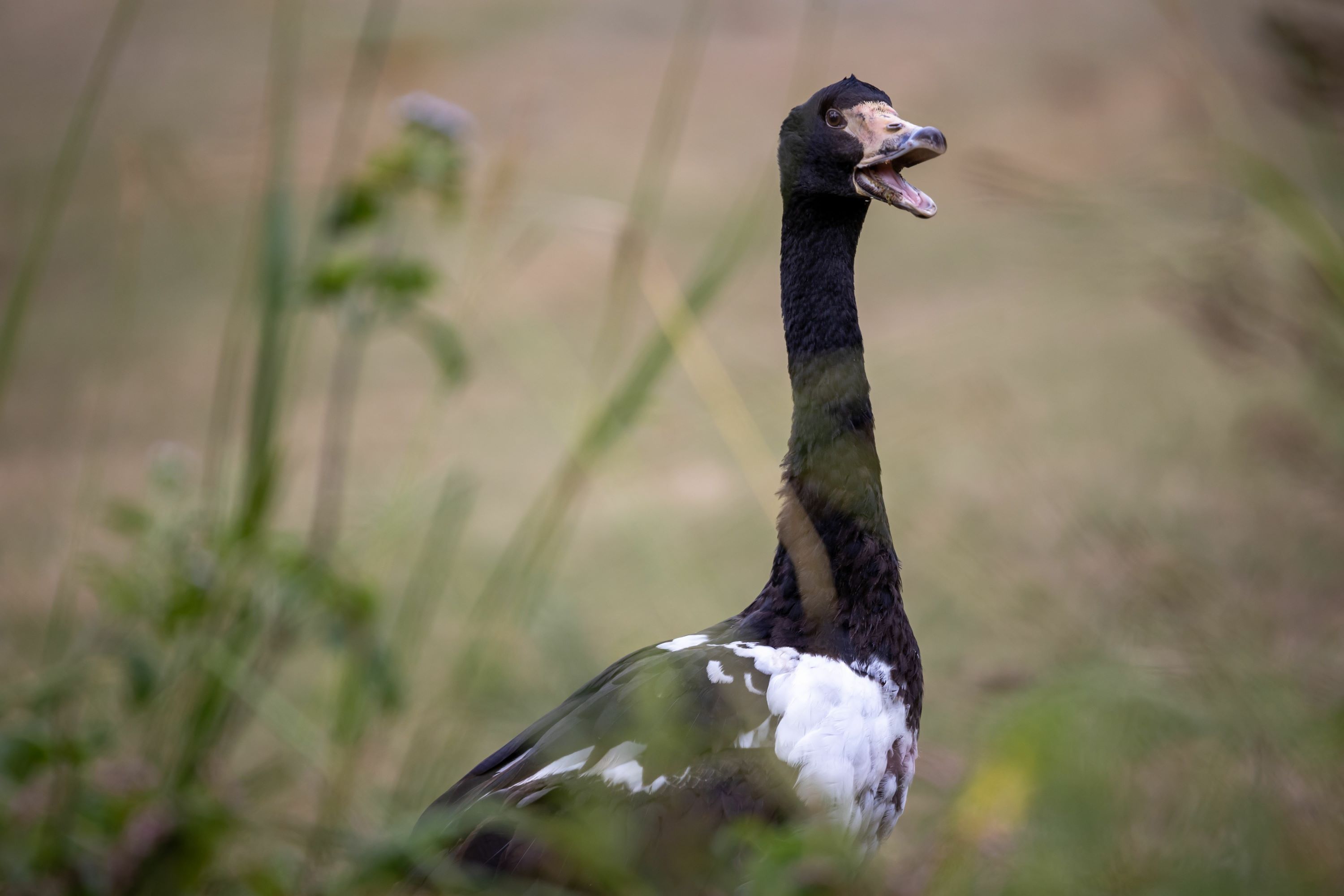
Diet and Foraging of the Magpie Goose
The dietary habits of the Magpie Goose (Anseranas semipalmata) play a crucial role in both its survival and the ecological balance of its habitat. Primarily herbivorous, these birds have a diet that predominantly consists of a variety of aquatic vegetation, making them integral components in the ecosystems they inhabit. Their feeding regimen includes a diverse array of aquatic plants, which they skillfully forage with their long necks and robust bills. These plants are not only a source of nourishment but also contribute to the maintenance of their habitats. Additionally, the Magpie Goose feeds on seeds and grasses, often venturing into flooded or wet grasslands, where they graze much like terrestrial herbivores. This dietary diversity is crucial for their sustenance, especially in the fluctuating water levels of their wetland habitats.
In their natural environment, Magpie Geese are often observed foraging in shallow waters. Their partially webbed feet enable them to wade effortlessly, often immersing their heads underwater to reach aquatic plants. They are adept at maneuvering through dense aquatic vegetation, where they selectively feed on preferred plant species. This foraging behavior is not only essential for their diet but also plays a significant role in controlling the growth of aquatic vegetation. By feeding on these plants, Magpie Geese help maintain a balance in the wetland flora, preventing overgrowth that could otherwise disrupt the ecological equilibrium of these water bodies.
Furthermore, when foraging on land, particularly in wet grasslands, their grazing activity contributes to the health of these ecosystems. By consuming grasses and seeds, they aid in seed dispersal and vegetation management, ensuring a healthy and diverse grassland environment. This interaction highlights the Magpie Goose's role as an ecological engineer, actively contributing to habitat maintenance and biodiversity.
The Magpie Goose's feeding habits are a vital aspect of their life history, reflecting their adaptation to the wetland ecosystems of northern Australia and southern New Guinea. Their diet and foraging patterns not only underscore their importance in the ecological network of their habitats but also provide an insight into the complex relationships between avian species and their environments. Understanding these dynamics is crucial for conservation efforts, emphasizing the need to preserve the natural habitats that support such unique and ecologically significant species.
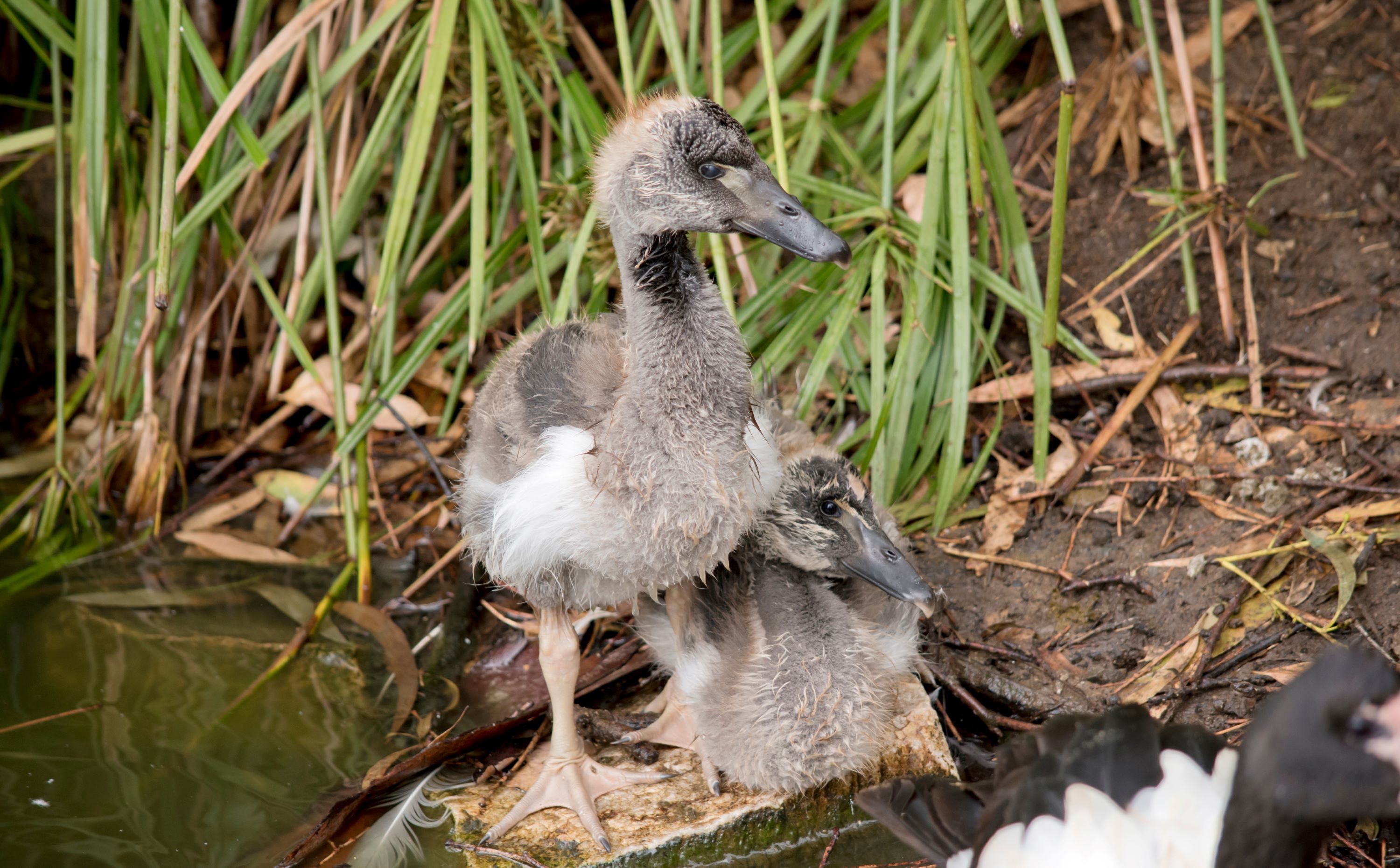
Breeding and Nesting Habits of the Magpie Goose
The breeding behavior of the Magpie Goose (Anseranas semipalmata) is particularly notable for its uniqueness among waterfowl. These birds exhibit a fascinating social structure when it comes to reproduction, often forming breeding trios that consist of one male and two females. This polygamous arrangement is relatively uncommon in the bird world and highlights the complex social dynamics of the species. Within these trios, there is a cooperative approach to nesting and raising the young, which ensures higher survival rates for the goslings in the challenging environments they inhabit.
The nesting sites chosen by Magpie Geese are as unique as their breeding behavior. They typically construct their nests on floating vegetation, such as lily pads or reeds, or in dense reed beds that offer protection from predators and stability amidst fluctuating water levels. These nests are strategically positioned to provide safety for the eggs and goslings from terrestrial predators, leveraging the natural defense provided by water.
The females in the breeding trio each lay a clutch of eggs in the shared nest, which can result in a sizeable collective brood. The eggs are laid at staggered intervals, ensuring a continuous incubation period. Remarkably, all adults in the trio participate in the incubation process, taking turns to maintain the necessary warmth and protection for the eggs. This communal approach to incubation is a key factor in the successful hatching of the goslings.
Once hatched, the goslings receive care from all adult members of the trio. They are precocial, meaning they are relatively mature and mobile from birth, but still rely on the guidance and protection of their parents. The adults teach the goslings essential survival skills, including foraging techniques and predator avoidance. This extended parental care plays a crucial role in the development of the young, preparing them to navigate the complexities of their wetland habitats.
The breeding and nesting habits of the Magpie Goose are not only fascinating from a behavioral standpoint but also have significant implications for the species' survival and adaptation. Their cooperative breeding strategy, choice of nesting sites, and communal care for the young are all integral components of their life history, reflecting a high degree of adaptation to their specific environmental conditions. Understanding these aspects of the Magpie Goose's biology provides valuable insights into the evolutionary and ecological processes that shape the behavior and survival strategies of waterfowl.

Conservation Status of the Magpie Goose
The Magpie Goose (Anseranas semipalmata) currently holds the status of 'Least Concern' on the International Union for Conservation of Nature (IUCN) Red List, indicating that it is not presently at immediate risk of widespread decline. However, this classification should not overshadow the real threats this species faces in its natural habitats. The Magpie Goose's survival is closely tied to the health and availability of wetland ecosystems, which are increasingly under threat from human activities.
One of the primary threats to the Magpie Goose is the destruction and alteration of its natural habitats. In particular, the draining of wetlands for agricultural expansion poses a significant risk. Wetlands are often viewed as prime areas for conversion to farmland, leading to the loss of crucial feeding and breeding grounds for the Magpie Goose. This habitat loss not only reduces the available space for these birds to live and reproduce but also fragments their populations, potentially leading to isolated groups that are more vulnerable to further environmental pressures.
In response to these challenges, conservation efforts are being directed towards preserving and restoring the wetland habitats vital to the Magpie Goose. These initiatives involve a range of strategies, including the designation of protected areas, the implementation of sustainable land and water management practices, and the restoration of degraded wetland sites. Conservation programs also focus on raising awareness about the ecological importance of wetlands, not only for the Magpie Goose but for a host of other species that depend on these habitats.
Additionally, research and monitoring are key components of these conservation efforts. By studying the Magpie Goose's population trends, breeding success, and habitat usage, conservationists can gain a better understanding of the species' needs and the effectiveness of various protection measures. This information is crucial in guiding policy decisions and management actions that can help ensure the long-term survival of the Magpie Goose.
While the Magpie Goose is not currently considered endangered, its future depends heavily on the conservation and management of the wetlands it inhabits. Ongoing efforts to protect these environments are essential, not only for the Magpie Goose but for the overall health of the ecosystems where they thrive. The species' status as Least Concern should be viewed as an opportunity to reinforce and expand conservation measures, ensuring that these unique birds continue to flourish in their natural habitats.
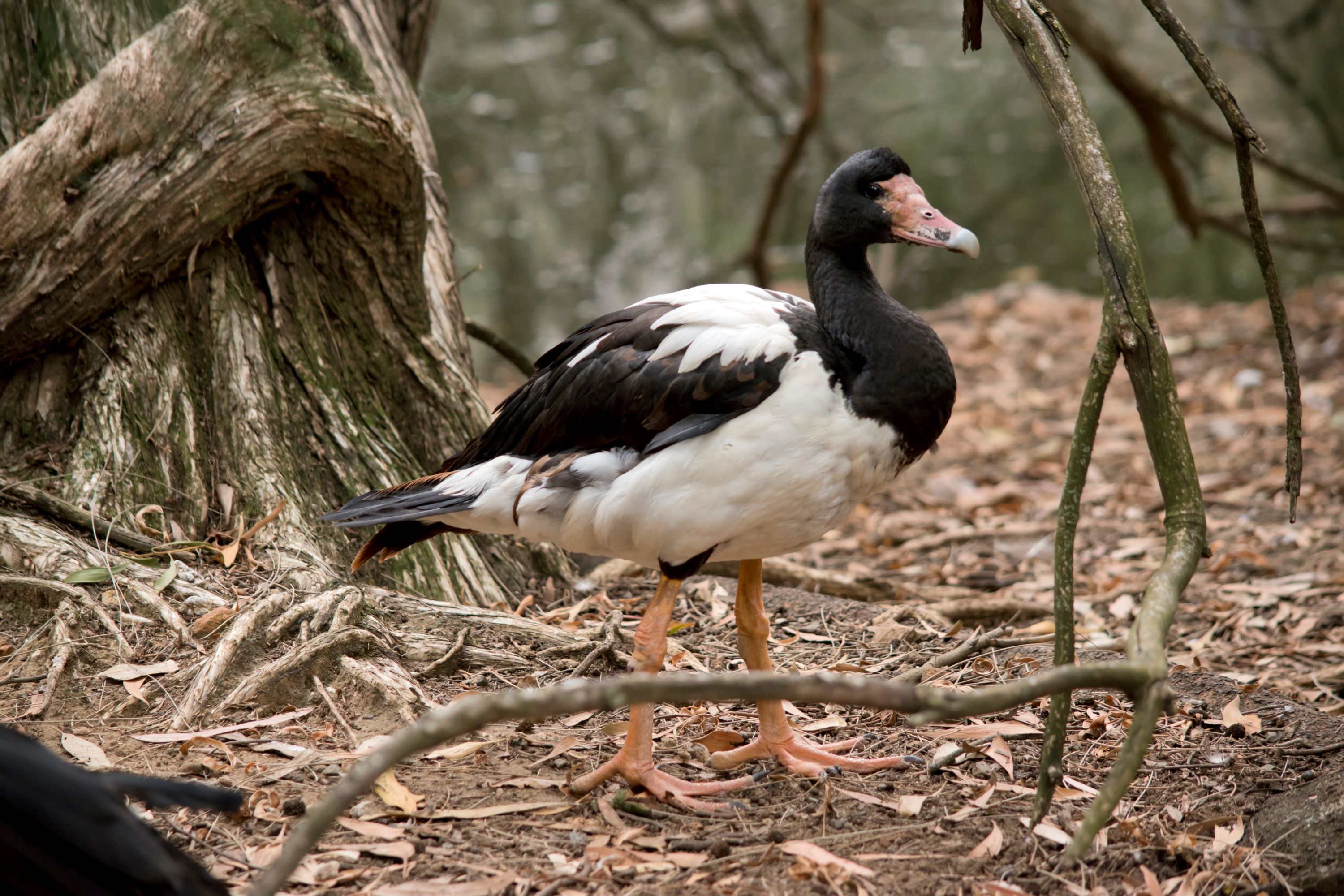
The Magpie Goose in the Global Birdwatching Arena
The Magpie Goose (Anseranas semipalmata), though absent from the birding landscapes of Utah and much of North America, holds a place of considerable interest in the global birdwatching community. This intrigue is sparked by several factors that make the Magpie Goose a unique specimen among waterfowl. Bird enthusiasts and ornithologists around the world are drawn to this species for its distinctive characteristics and the ecological roles it plays in its native habitats.
Firstly, the Magpie Goose's breeding system is a subject of particular fascination. The species is known for its uncommon polygamous relationships, often forming trios that consist of one male and two females. This breeding arrangement, along with their cooperative nesting and rearing of young, provides a captivating study in avian social structures and reproductive strategies. It deviates significantly from the breeding behaviors observed in most other waterfowl species, offering valuable insights into the diverse ways bird species adapt their reproductive strategies to their environments.
Moreover, the Magpie Goose's physical appearance sets it apart. With its striking black and white plumage, long neck, and elongated legs, combined with its prominent, bright orange facial skin and legs, the Magpie Goose is a visually arresting bird. The contrast in its feather coloring, along with its unique facial features, makes it an easily identifiable and memorable species for birdwatchers. Its ability to perch in trees, a rare trait among ducks and geese, adds another layer of uniqueness to its profile.
Additionally, the Magpie Goose plays a significant role in the ecology of wetland environments. As a species that primarily feeds on a variety of aquatic vegetation, it contributes to the health and maintenance of wetland ecosystems. This role is particularly important given the global challenges facing wetlands, such as habitat destruction and climate change. Observing the Magpie Goose in its natural habitat offers birdwatchers a chance to appreciate not only the bird itself but also the crucial ecological functions these environments perform.
In conclusion, the Magpie Goose represents an intriguing subject within the global birdwatching community. Its unique breeding behavior, distinctive appearance, and ecological significance in wetland habitats make it a species of great interest and importance. For birdwatchers and nature enthusiasts, understanding and appreciating the Magpie Goose is not only a matter of admiring a singular bird species but also recognizing the broader complexities and wonders of avian life and the ecosystems they inhabit.
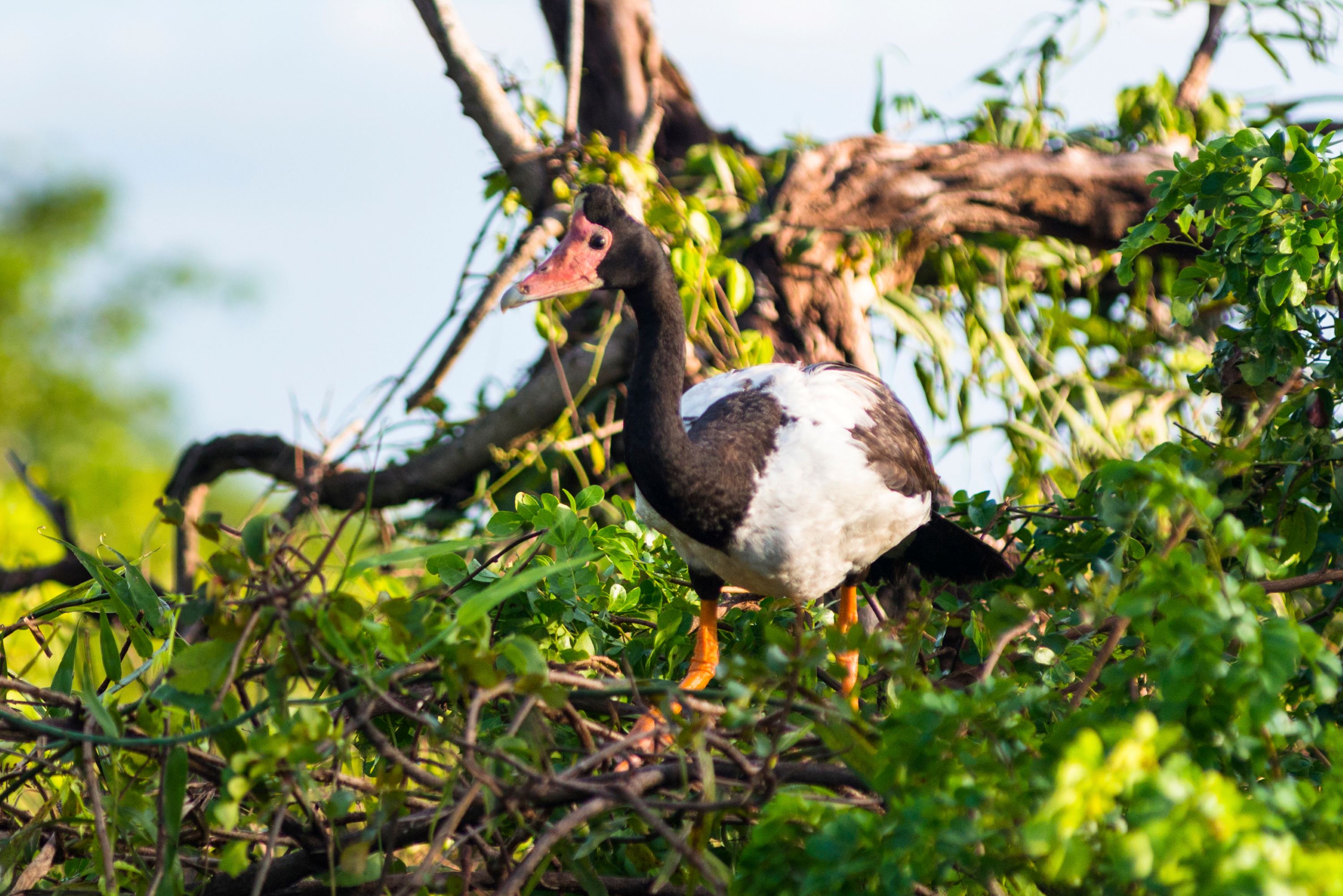
Conclusion: The Significance of the Magpie Goose in the Avian World
The Magpie Goose (Anseranas semipalmata) stands as a striking testament to the incredible diversity and complexity inherent in the world of waterfowl. With its distinctive black and white plumage, elongated neck, and legs, and the vivid orange-red hue of its face and legs, this species commands attention and admiration. Its evolutionary lineage is particularly noteworthy, representing an ancient branch of the waterfowl family tree, and thus offers invaluable insights into the evolutionary history of these birds. The Magpie Goose's physical adaptations, including its partially webbed feet, are a remarkable testament to the evolutionary ingenuity that allows species to thrive in specific ecological niches.
Although the Magpie Goose is not a resident of Utah's diverse landscapes, its existence is a reminder of the vast array of unique and fascinating bird life that populates our planet. It exemplifies the beauty and complexity of the natural world, reinforcing the importance of international conservation efforts. Protecting the Magpie Goose and its habitat is not just about preserving a single species; it's about safeguarding the intricate web of life that supports biodiversity and ecological balance. The Magpie Goose's story is a call to action, encouraging us to appreciate, study, and protect the myriad avian species and their natural environments that enrich our world.